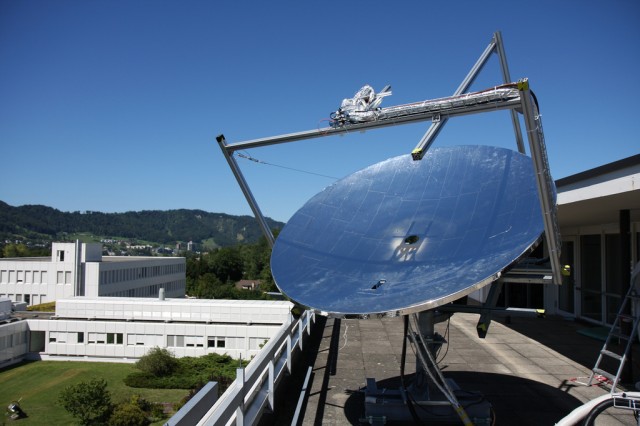
By borrowing cooling systems used in its supercomputers, IBM Research claims it can dramatically increase the overall efficiency of concentrated photovoltaic solar power from 30 to 80 percent.
Like other concentrated photovoltaic (CPV) collectors, IBM's system at its Zurich laboratory uses a mirrored parabolic dish to concentrate incoming solar radiation onto PV cells. The dish uses a tracking system to move with the sun, concentrating the collected radiation by a factor of 2,000 onto a sensor containing triple-junction PV cells. During daylight hours, each 1-sq cm PV chip generates on average between 200 and 250 watts of electrical power, harnessing up to 30 percent of the incoming solar energy.
Ordinarily, the remaining 70 percent of energy would be lost as heat. But by capturing most of that heat with water, IBM Research says it is able to reduce system heat losses to around 20 percent of the total incoming energy. This results in a bottom-line efficiency of 80 percent for its CPV collector, dubbed HCPVT for High Concentration Photovoltaic Thermal. Unlike a regular CPV system, HCPVT delivers its energy in two forms: electricity and hot water.
The thermal system was adapted from IBM Research's 6-teraflop Aquasar supercomputer, which went online at ETH Zurich in 2010. By using water as a coolant, Aquasar consumes three fifths of the energy of a comparable air-cooled machine of the time. Crucially, the hot water could be put to work heating university buildings, reducing Aquasar's carbon footprint to a claimed 15 percent of what would otherwise have been the case.
As with Aquasar, micro-channels between 50 and 100 micrometers in diameter carry water exceptionally close to the source of heat: the processing units in the case of Aquasar, the PV cells here. Thermal resistance is reduced to a tenth of competing systems with larger water channels.
"This allows us to cool with hot water, which sounds a bit strange," IBM scientist Dr. Bruno Michel told Ars during a Skype call. "The photovoltaic chip is around 100º [centigrade] while the coolant is 90º."
To live up to its efficiency, the HCPVT system needs to put its hot water to good use. Though outside the scope of this team's work, IBM Research is also looking at systems which could use the heat by-product to purify water or, somewhat counterintuitively, to cool buildings using adsorption refrigeration.

The team has developed a prototype with a 4×4-cm PV receiver which generates about 1kW of electrical power. It hopes to develop a much larger HCPVT system with a 100-sq m dish and a 25×25 cm receiver, producing 25kW of electrical power and 50kW of thermal power. (Larger PV receivers have gaps between the chips, so you don't gain an additional 200W of electrical power for every square centimeter of receiver you add.)
In a YouTube video, Dr. Michel raises the possibility that these larger HCPVT collectors could one day be used to build solar power stations in, say, the Sahara Desert. According to the team's calculations, covering 2 percent of the area of the Sahara with HCPVT would meet the world's electricity needs, transmission issues aside. Not that you need a desert. Michel told Ars that the system is useful almost anywhere where you have direct solar radiation—Zurich, for instance. "By adding the thermal output we can extend its range of applications compared to CPV," he said.
The HCPVT system has been in development for more than 5 years, initially in collaboration with the Egypt Nanotechnology Research Center.
reader comments
99